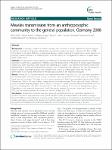Measles transmission from an anthroposophic community to the general population, Germany 2008
Wadl, Maria
Siedler, Anette
Krämer, Wolfgang
Haindl, Maria E.
Gebrande, Stephan
Krenn-Lanzl, Irene
Mankertz, Annette
Hautmann, Wolfgang
Background: In Germany, measles vaccination coverage with two doses is not yet sufficient to prevent regional outbreaks. Among the 16 German federal states, vaccination coverage was lowest in Bavaria with 85% in 2008. From March to mid-April 2008, four neighbouring Bavarian counties reported 55 measles-cases mostly linked to an ongoing measles outbreak in an anthroposophic school in Austria. We investigated this outbreak to guide future public health action. Methods: We applied the German national case-definition for measles and collected data using the national surveillance system and a questionnaire. Measles cases with disease onset a maximum of 18 days apart and spatial contact (e.g. same household, same school) were summed up in clusters. Two different interventions, which were implemented in schools and kindergartens in Bavaria, were compared by their impact on the size and duration of measles clusters. Susceptible persons were excluded from schools or kindergartens either with the first (intervention A) or second (intervention B) measles case occurring in the respective institution. Results: Among the 217 Bavarian measles cases identified from March-July 2008, 28 (13%) cases were attendees of the anthroposophic school in Austria. In total, vaccination status was known in 161 (74%) cases and 156 (97%) of them were not vaccinated. The main factor for non-vaccination was “fear of vaccine-related adverse events” (33%). Twenty-nine (18%) of 161 cases suffered complications. Exclusively genotype D5 was detected. Overall, 184 cases could be epidemiologically grouped into 59 clusters. Of those, 41 clusters could be linked to households and 13 to schools or kindergartens. The effect of intervention A and B was analysed in 10 school or kindergarten clusters. Depending on the respective intervention A or B, the median number of cases per cluster was 3 versus 13 (p = 0.05), and the median duration of a cluster was 3 versus 26 days (p = 0.13). Conclusions: Introduction of measles virus into a pocket of susceptible persons (e.g. vaccination opponents or sceptics) may lead to large outbreaks in the general population, if the general population’s vaccination coverage is below the WHO recommended level. Education on the safety of measles vaccine needs to be strengthened to increase measles vaccination coverage. Early intervention may limit spread in schools or kindergartens. Suspected measles has to be reported immediately to the local health authorities in order to allow intervention as early as possible.
Dateien zu dieser Publikation
Keine Lizenzangabe

